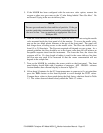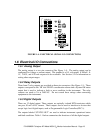
Input Description
1 Zero Calibrate
2 Undefined (Spare)
3 Undefined (Spare)
4 Undefined (Spare)
5 Undefined (Spare)
6 Undefined (Spare)
TABLE 1.2 CONTROL INPUTS
Zero Calibrate:
The zero calibration input is used to initiate zero calibration from an external device.
This control input only functions when the instrument has been configured with the
Auto-Zero option. To perform the Auto-Zero calibration using the control input, this
input should be closed for at least 2 seconds and released. The instrument will then
automaticall perform the zero calibration and return to normal monitoring afterwards.
See Section 3.5 for details on configuring the Auto-Zero feature.
1.6.5 RS232 Output
The RS232 output is provided on the 9-pin D-Sub connector shown in Figure 1.4. The
RS232 output can be connected to a computer or serial printer. The RS232 output can be
used to record alarm events with a time and date stamp or can be used to control the
instrument’s operation remotely using a computer. Almost any function that can be done
through the front panel interface can also be done remotely through the RS232 interface.
To use the RS232 for instrument control, all that is needed is a PC(personal computer)
with an available serial communications port(COM port), a serial cable, and terminal
emulation software. The serial cable must have a female DB-9 connector on one end and
an appropriate connector on the other end to interface with the COM port on a PC.
For more details on the use of the RS232 interface, please contact Teledyne API and
request document number 01350.
P/N 02826B1 Teledyne API Model 450H O
3
Monitor Instruction Manual - Page 21


















